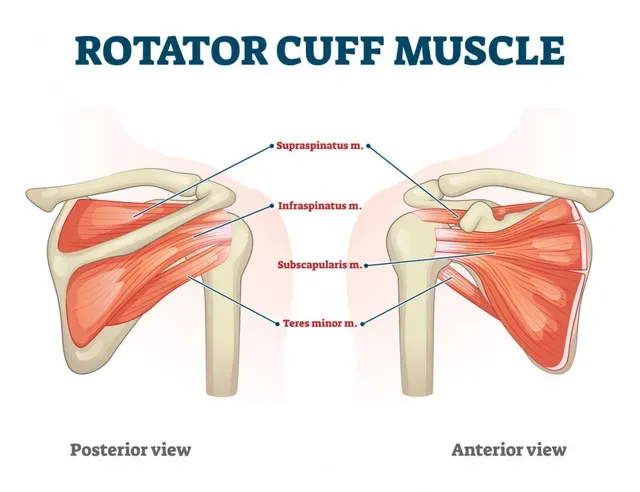The rotator cuff is a group of muscles surrounding the shoulder joint. These muscles include the supraspinatus, infraspinatus, teres minor, and subscapularis. While these muscles have specific individual actions, they also act as a group to stabilize the shoulder joint with movement. These muscles are required for stability due to the inherit instability of the shoulder’s shallow ball and socket joint.
Rotator cuff tears are common in all age groups, but the incidence increases dramatically over the age of 40. According to Minagawa et. al., 22.1% of the general population is affected by rotator cuff tears (3). Rotator cuff tears can be traumatic, with an initial injury, or degenerative, meaning they happen progressively. Traumatic rotator cuff tears commonly occur with a fall on an outstretched hand, and unexpected pulling or pushing force, or during a shoulder dislocation. Degenerative rotator cuff tears are common in occupations with overhead work (construction workers, painters) and overhead sports (baseball, tennis, etc.). Normal age related degenerative changes with excessive repeated stresses also can cause atraumatic tears (1). Symptoms of a rotator cuff tear may include: pain at night, pain with overhead activities, shoulder weakness, shoulder stiffness, and/or severe pain at the time of injury (2). If someone is suffering from shoulder pain, it is important to see a physical therapist or physician for proper diagnosis and treatment. While these symptoms are common with rotator cuff tears, one could be suffering from another pathology such as shoulder osteoarthritis, acromioclavicular joint injury, glenoid labral tear, subacromial impingement, shoulder instability, adhesive capsulitis, or others. The shoulder is a complex structure that requires appropriate treatment from a specialist.
While a rotator cuff tear can sound debilitating and frightening, asymptomatic rotator cuff tears are actually twice as common as symptomatic tears (3). In fact, a research article in the Journal of Orthopedics states that rotator cuff tears should be considered “normal” to a certain extent due to the high prevalence of asymptomatic tears (4). Thus, one with a symptomatic rotator cuff tear may regain their function with proper treatment, avoiding the need for surgery. In more severe cases, and with failure of conservative treatments, surgery becomes a more appropriate option.
As stated previously, it is important to visit your health care provider for diagnosis and treatment of your shoulder pathology. It is possible to return to your prior level of function with a rotator cuff tear, or any other shoulder pathology. While the prevalence of rotator cuff tears is common, pain should always be addressed.
Author: Dr. Osama Imam PT, DPT, Cert. DN
References:
1. Huo HC, Luo ZP, Cofield RC, An KN. Influence of rotator cuff tearing on glenohumeral stability. Journal of Shoulder and Elbow Surgery. 1997; 6(5):413 – 422, (2B), (E)
2. Lädermann A, Denard PJ,Collin P . Massive rotator cuff tears: definition and treatment. International orthopaedics. 2015; 39(12): 1-12. (2C)
3. Minagawa, H., Yamamoto, N., Abe, H., Fukuda, M., Seki, N., Kikuchi, K., Kijima, H., & Itoi, E. (2013). Prevalence of symptomatic and asymptomatic rotator cuff tears in the general population: From mass-screening in one village. Journal of orthopaedics, 10(1), 8–12. https://doi.org/10.1016/j.jor.2013.01.008
4. Tempelhof, S., Rupp, S., & Seil, R. (1999, August). Age-related prevalence

